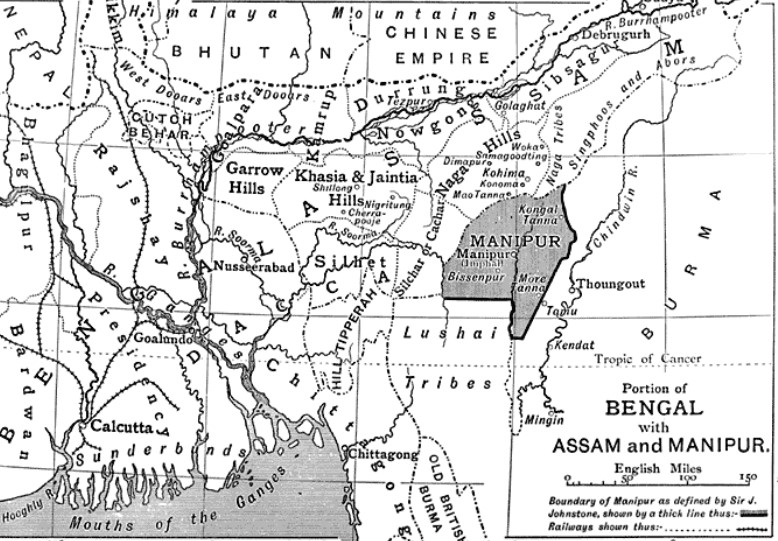FORMATION OF NAGA HILLS
It was in 1832 when the Nagas came in contact with the British when two British captains, Francis Jenkins and R.B. Pemberton traveled through Angami territory, with a party of 700 soldiers and 800 coolies, in search of a route between Manipur and Assam. Following this, there were frequent clashes between the Nagas and the British.
1866: Creation of Naga Hills district
- The Naga Hills district was created in 1866 by the Government of British India and Naga Hills became a district of Assam Province with its headquarters at Samaguting (present day Chumukedima).
- Captain Gregory, was the first Officer in Charge (Deputy Commissioner) of the newly formed Naga Hills District. He was succeeded in 1869 by Captain John Butler.
The British’s non-interference policy having failed, the British took over the Angami Naga territory first. Later, the British formed a new district known as Naga Hills under Assam with district headquarters at Samaguting (present day Chumukedima) in 1866. The Naga Hills district was declared a scheduled district, meaning that the Naga Hills District was excluded from the general laws prevailing throughout the rest of British India. Decision to abandon the policy of non-interference was taken in 1866, and the same year, the Government sanctioned the establishment of a strong post under Lieutenant Gregory at Samaguting in 1866, for administrative reasons and also to stop raids upon British territory.

Meanwhile, the Lothas resisted bravely against the British. In one encounter, John Butler, the leader of the British survey party was killed at Pangti, Wokha. In 1875, the British took over Lotha Naga country and opened up a sub-division at Wokha with Wokha as the headquarter. Later the headquarter of Naga Hills shifted to Wokha in 1876. With this move, the British hoped to conquer the Eastem Naga Hills. The British continued their territorial expansion in the Angami areas. On 14 November 1878, the Naga Hills District Headquarters was shifted once again to Kohima, and Wokha remained a Sub Division.
Originally known as Kewhira, Kohima was founded in 1878 when the British Empire established its headquarters of the then Naga Hills. It officially became the capital of Nagaland after the state was inaugurated in 1963.
In 1881, Kohima was declared the permanent HQ of the Naga Hills and Samaguting was abandoned, with a sub Division at Wokha. By 1889, Ao area also completely came under the British, and outposts were established in Mokokchung the same year. The same year, the sub division HQ was shifted from Wokha to Mokokchung.
North-East Frontier Tract (NEFT)
In 1914, some tribal-majority areas were separated from the former Darrang and Lakhimpur districts of Assam Province of British India to form the North-East Frontier Tract (NEFT). The NEFT was initially divided into two sections:
(i) the Central & Eastern Section and
(ii) the Western Section.
Each section was placed under a political officer.
Meanwhile,
1918: Formation of Naga Club
During the Kuki revolt (1917–19) and the World War I (1914–18), the British Government recruited a number of labourers and porters from the Naga tribes. As part of the labour corps, around 2000 Nagas were sent to France, where, alienated from the other British Indian troops, they developed a sense of unity. They agreed that after returning to their homeland, they will work towards unity and friendship among the various Naga tribes. These Nagas, together with the British officials, formed the Naga Club in 1918.
Naga Club – the first sign of Naga resistance – provided the socio-political foundation for the Naga nationalist movement.
1929: Memorandum to the Simon Commission
Naga Club submitted memorandum to the Simon Commission requesting that the Nagas should be given a choice of self-determination after the British departure from India.
Excludes Areas
The British Government realized that all tribal areas in India needed a special kind of administration and this was more so in ease of hill areas. The hill tribes were simple and unsophisticated and needed delicate handling. The Naga tribes were by a Regulation of 1880 “Excluded” from coming under such laws as may be complex or in any way unsuitable to them. The Nagas have traditional laws to guide their conduct and village courts to deal with crimes both civil and criminal. These were effective enough and the British Government did not seek to make changes. Considering the special requirements of such areas and recognizing the need of protecting the people of such areas from possible economic exploitation, they were excluded from general constitutional arrangements. From 1st April 1937, the Naga hill districts along with the North-East Frontier Tract, the Lushai and North Cachar Hills were declared “Excluded Areas” of the province of Assam.
1939, April 1: British District “Naga Hills” declared as “Naga Hills Excluded Area” under the Government of India.
1945, April: Formation of Naga Hills District Tribal Council
-
In April 1945, the deputy commissioner of the Naga Hills District, C. R. Pawsey, established the Naga Hills District Tribal Council as a forum of the various Naga groups in the district.
-
Naga Hills District Tribal Council replaced the Naga Club.
After India’s Independence…
North-East Frontier Agency (NEFA)
In 1951, Balipara Frontier Tract, Tirap Frontier Tract, Abor Hills district, Mishmi Hills district and the Naga tribal areas (Tuensang and Mon areas) were together renamed as the North-East Frontier Agency (NEFA).
On 26 January 1954 the North-East Frontier Agency was divided into six frontier divisions:
- Kameng (formerly Sela Sub-Agency),
- Subansiri (formerly Subansiri area),
- Tirap (formerly Tirap Frontier Tract),
- Siang (formerly Abor Hills district),
- Lohit (formerly Mishmi Hills district) and
- Tuensang Frontier Division.
Naga Hills-Tuensang Area (NHTA)
- On 1 December 1957, Tuensang Frontier Division was separated from NEFA and attached to the newly formed Naga Hills District to form a centrally governed Naga Hills-Tuensang Area with creation of Kohima, Mokokchung and Tuensang districts.
- Kohima, Mokokchung and Tuensang were the first districts in the Naga Hills.
Formation of Nagaland State
In February 1961, Naga Hills Tuensang Area was renamed to “Nagaland“. On 1 December 1963, Nagaland became a full fledged state – the 16th state of India. At the time of inauguration of the Statehood there were three districts, namely Kohima, Mokokchung and Tuensang.
NEXT: History # 8 – BATTLE OF KOHIMA
PREVIOUS:
- History #1 – The Naga People
- History #2 – Origin of the Word ‘Naga’
- History #3 – Migration of The Nagas
- History # 4 – The Nagas and the Ahoms
- History # 5 – The Nagas during British Rule
- History # 6 – Battle of Khonoma



Leave a Comment (FB)